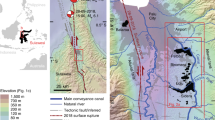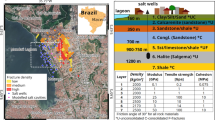Abstract
The death toll and economic impact of an earthquake can be greatly exacerbated if seismic ground shaking triggers landslides. Earthquake-triggered landslides typically occur in two different contexts: localized failure of steep slopes and resulting landslides that pose a major threat to life in areas below; and lateral spreading of nearly flat sediment plains due to shaking-induced liquefaction, which can damage large areas of critical infrastructure. Unexpected catastrophic landsliding triggered by the 28 September 2018 earthquake at Palu, Indonesia did not occur in either typical context, but produced both destructive outcomes. Here, we show that alluvial ground failure in the Palu Valley was a direct consequence of irrigation creating a new liquefaction hazard. Aqueduct-supported cultivation, primarily of wet rice, raised the water table to near ground level, saturating sandy alluvial soils that liquefied in response to strong ground shaking. Large-displacement lateral spreads occurred on slopes of 1°. Slopes steeper than 1.5° sourced long-runout landslides and debris flows that swept through villages occupying the gentler slopes below. The resulting damage and loss of life would probably not have occurred in the absence of a raised water table. Earthquake-triggered landsliding of gentle, irrigated alluvial slopes is an under-recognized, but avoidable, anthropogenic hazard.
This is a preview of subscription content, access via your institution
Access options
Access Nature and 54 other Nature Portfolio journals
Get Nature+, our best-value online-access subscription
$29.99 / 30 days
cancel any time
Subscribe to this journal
Receive 12 print issues and online access
$259.00 per year
only $21.58 per issue
Buy this article
- Purchase on Springer Link
- Instant access to full article PDF
Prices may be subject to local taxes which are calculated during checkout




Similar content being viewed by others
Data availability
The data required to reproduce our conclusions are available at the NTU Data Repository (https://researchdata.ntu.edu.sg/). The data included are: horizontal displacements from object tracking and pixel correlation, pixel correlation strain maps, land use classification and mapped geological features. MicMac displacement maps can be found at https://doi.org/10.21979/N9/VTBCFL. Strain rasters can be found at https://doi.org/10.21979/N9/PNYMEQ. Object tracking displacements can be found at https://doi.org/10.21979/N9/WPDFX2. Geological feature KMZ files can be found at https://doi.org/10.21979/N9/BZNMU0. The land use classification map can be found at https://doi.org/10.21979/N9/AFWLAR.
Code availability
The MATLAB function used to calculate horizontal strain components is available at the NTU Data Repository: https://doi.org/10.21979/N9/FLOXET.
References
Bao, H. et al. Early and persistent supershear rupture of the 2018 magnitude 7.5 Palu earthquake. Nat. Geosci. 12, 200–205 (2019).
Socquet, A., Hollingsworth, J., Pathier, E. & Bouchon, M. Evidence of supershear during the 2018 magnitude 7.5 Palu earthquake from space geodesy. Nat. Geosci. 12, 192–199 (2019).
Bellier, O. et al. High slip rate for a low seismicity along the Palu‐Koro active fault in central Sulawesi (Indonesia). Terra Nova 13, 463–470 (2001).
Socquet, A. et al. Microblock rotations and fault coupling in SE Asia triple junction (Sulawesi, Indonesia) from GPS and earthquake slip vector data. J. Geophys. Res. 111, B08409 (2006).
Worden, C. B. et al. Spatial and spectral interpolation of ground‐motion intensity measure observations. Bull. Seismol. Soc. Am. 108, 866–875 (2018).
M 7.5 – 70km N of Palu, Indonesia (United States Geological Survey, 2018); https://earthquake.usgs.gov/earthquakes/eventpage/us1000h3p4/executive
Gempa Bumi M7,4 & Tsunami Sulawesi Tengah (Badan Nasional Penggulangan Bencana, 2019); https://bnpb.go.id/infografis-gempabumi-m74-tsunami-sulawesi-tengah
Dai, F. C. et al. Spatial distribution of landslides triggered by the 2008 Ms 8.0 Wenchuan earthquake, China. J. Asian Earth Sci. 40, 883–895 (2011).
Marano, K. D., Wald, D. J. & Allen, T. I. Global earthquake casualties due to secondary effects: a quantitative analysis for improving rapid loss analyses. Nat. Hazards 52, 319–328 (2010).
Nowicki Jessee, M. A. et al. A global empirical model for near-real-time assessment of seismically induced landslides. J. Geophys. Res. 123, 1835–1859 (2018).
Wang, C. Y. Liquefaction beyond the Near Field. Seismol. Res. Lett. 78, 512–517 (2007).
Bertrand, R. La «Politique éthique» des Pays-Bas à Java (1901–1926). Vingtième Siècle 93, 115–138 (2007).
Kreisel, W., Weber, R. & Faust, H. Colonial interventions on the cultural landscape of Central Sulawesi by “Ethical Policy”: the impact of the Dutch rule in Palu and Kulawi Valley, 1905–1942. Asian J. Soc. Sci. 31, 398–434 (2003).
Metzner, J. Palu (Sulawesi): problems of land utilization in a climatic dry valley on the Equator. Erdkunde 35, 42–54 (1981).
Planet Application Program Interface: In Space for Life on Earth (Planet Team, 2017); https://api.planet.com
Rosu, A. M., Pierrot-Deseilligny, M., Delorme, A., Binet, R. & Klinger, Y. Measurement of ground displacement from optical satellite image correlation using the free open-source software MicMac. ISPRS J. Photogramm. Remote Sens. 100, 48–59 (2015).
Kääb, A., Altena, B. & Mascaro, J. Coseismic displacements of the 14 November 2016 Mw 7.8 Kaikoura, New Zealand, earthquake using the Planet optical cubesat constellation. Nat. Hazards Earth Syst. Sci. 17, 627–639 (2017).
Seed, H. B. Landslides during earthquakes due to liquefaction. J. Soil Mech. Found. Div. 94, 1055–1122 (1968).
Seed, H. B. & Idriss, I. M. Analysis of soil liquefaction: Niigata earthquake. J. Soil Mech. Found. Div. 93, 83–108 (1967).
Bouman, B. A. M., Lampayan, R. M. & Tuong, T. P. Water Management in Irrigated Rice: Coping with Water Scarcity (International Rice Research Institute, 2007).
Carr, M. The water relations and irrigation requirements of coconut (Cocos nucifera): a review. Exp. Agric. 47, 27–51 (2011).
King, G. C. P., Stein, R. S. & Lin, J. Static stress changes and the triggering of earthquakes. B. Seismol. Soc. Am. 84, 935–953 (1994).
Watkinson, I. M. & Hall, R. Fault systems of the eastern Indonesian triple junction: evaluation of Quaternary activity and implications for seismic hazards. Geol. Soc. Spec. Publ. 441, SP441.448 (2016).
Yasuda, S. & Tohno, I. Sites of reliquefaction caused by the 1983 Nihonkai-Chubu earthquake. Soils Found. 28, 61–72 (1988).
Yasuda, S. & Harada, K. Measures developed in Japan after the 1964 Niigata Earthquake to counter the liquefaction of soil. In Proc. 10th National Conference on Earthquake Engineering 11 (Earthquake Engineering Research Institute, 2014).
Wang, C. Y., Cheng, L. H., Chin, C. V. & Yu, S. B. Coseismic hydrologic response of an alluvial fan to the 1999 Chi-Chi earthquake, Taiwan. Geology 29, 831–834 (2001).
Harvey, F. E. & Sibray, S. S. Delineating ground water recharge from leaking irrigation canals using water chemistry and isotopes. Groundwater 39, 408–421 (2001).
Ishihara, K., Okusa, S., Oyagi, N. & Ischuk, A. Liquefaction-induced flow slide in the collapsible loess deposit in Soviet Tajik. Soils Found. 30, 73–89 (1990).
Holzer, T. L., Bennett, M. J., Ponti, D. J. & Tinsley, J. C. Liquefaction and soil failure during 1994 Northridge earthquake. J. Geotech. Geoenviron. 125, 438–452 (1999).
Youd, T. L., Harp, E. L., Keefer, D. K. & Wilson, R. C. The Borah Peak, Idaho Earthquake of October 28, 1983—Liquefaction. Earthq. Spectra 2, 71–89 (1985).
Neumann, K., Verburg, P. H., Stehfest, E. & Muller, C. The yield gap of global grain production: a spatial analysis. Agr. Syst. 103, 316–326 (2010).
Sieh, K. & Natawidjaja, D. Neotectonics of the Sumatran fault, Indonesia. J. Geophys. Res. 105, 28295–28326 (2000).
Naing, T. A. A., Kingsbury, A. J., Buerkert, A. & Finckh, M. R. A survey of Myanmar rice production and constraints. J. Agr. Rural Dev. Trop. 109, 151–168 (2008).
Wessel, P. & Smith, W. H. New, improved version of Generic Mapping Tools released. EOS Trans. AGU 79, 579–579 (1998).
Planet Dump (OpenStreetMap, accessed 23 November 2018); https://planet.openstreetmap.org
Acknowledgements
Generic Mapping Tools34 was used to produce the figures. This research was supported by the Asian School of the Environment, Nanyang Technological University and the National Research Foundation Singapore and the Singapore Ministry of Education under the Research Centres of Excellence initiative. J.H. was supported by a Singapore National Research Foundation Fellowship (award no. NRF-NRFF2013-06). Part of the research was carried out at the Jet Propulsion Laboratory, California Institute of Technology, under a contract with the National Aeronautics and Space Administration. This work comprises Earth Observatory of Singapore contribution no. 230.
Author information
Authors and Affiliations
Contributions
K.B., R.M. and J.H. led the analysis and produced the primary results and figures. K.B. led the writing and all authors contributed to writing and editing the manuscript. D.A., E.M., J.M., A.S., B.B. and G.B. made field observations of the landslides and liquefaction. K.B., R.M., J.H., G.F., S.W. and N.D. produced the displacement maps and uncertainty analyses. K.B. and H.A. mapped liquefaction features and produced the land use classification. E.M.H. and S.-H.Y. provided insight into damage mapping, recovery and ground surface deformation at Palu.
Corresponding author
Ethics declarations
Competing interests
The authors declare no competing interests.
Additional information
Publisher’s note: Springer Nature remains neutral with regard to jurisdictional claims in published maps and institutional affiliations.
Supplementary information
Supplementary Information
Supplementary figures.
Rights and permissions
About this article
Cite this article
Bradley, K., Mallick, R., Andikagumi, H. et al. Earthquake-triggered 2018 Palu Valley landslides enabled by wet rice cultivation. Nat. Geosci. 12, 935–939 (2019). https://doi.org/10.1038/s41561-019-0444-1
Received:
Accepted:
Published:
Issue Date:
DOI: https://doi.org/10.1038/s41561-019-0444-1
This article is cited by
-
The influence of anthropogenic regulation and evaporite dissolution on earthquake-triggered ground failure
Nature Communications (2024)
-
Landslide topology uncovers failure movements
Nature Communications (2024)
-
River-damming landslides during the 1960 Chile earthquake (M9.5) and earlier events: implications for risk assessment in the San Pedro River basin
Natural Hazards (2024)
-
Slope stabilization through groundwater management with limited hydrogeological data: a case study from Majes, southern Peru
Environmental Earth Sciences (2024)
-
Mechanical interpretation of retrogressive failure in mild dip rock slopes induced by slope cutting and rainfall: a case study in Yunnan, China
Bulletin of Engineering Geology and the Environment (2024)



